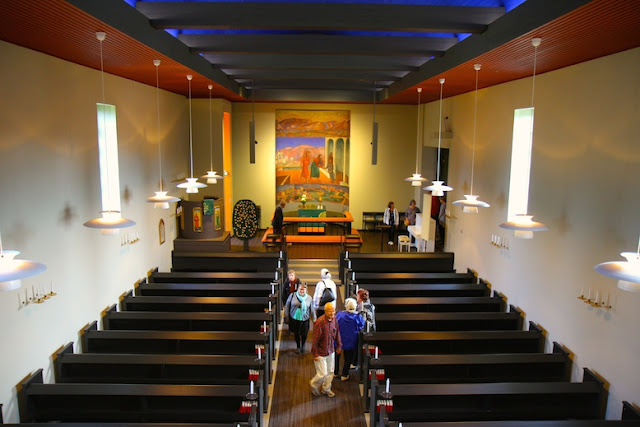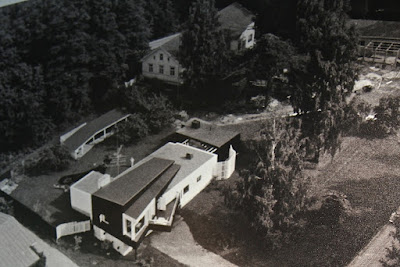Hi there,
 |
| Departing Jyväskylä |
just a few days ago I did a nice day trip to the city of Tammisaari which is located at the south-west coast of Finland. What is special about this small 15,000 people town is the fact that it is home to two Aalto buildings, a private home and a commercial building. While the commercial building is quite well know the private home has more been of a hidden spot. This was also due to the fact that the original owner, for whom Aalto had designed the house, had been living in the building until the beginning of this year. Because coming of age the owner moved at the beginning of 2018 to a flat and the house was finally opened to the public. Now the Christine and Göran Schildt foundation is taking care of the house and offers a limited amount of guided tours during this summer. Thanks to a work colleague who has read about those guided tours in the newspaper and alerted me I was able to attend one of those few and rare tours. Although the tours are still running until July 19th, they are all sold out by now. I was lucky enough to still get a spot in one of the tours.

However, coming the long way from Jyväskylä, I almost missed the rare chance to attend the booked tour because of a train delay due to a technical fault. Luckily I had booked tickets for the first train from Jyväskylä to Tammisaari departing at 5.28 am in order to be on time for the booked tour at noon. While I supposed to arrive in Tammisaari at 10.02 am, I just arrive on the spot a few minutes before the tour started at 12. Luckily the train company paid for a taxi that drove right to house.
Nevertheless, I still recommend to use the train in order to reach Tammisaari. About 100 kilometers from Helsinki to the west Tammisaari is a comfortable day trip destination and this lovely coastal town has certainly more to offer and to do besides visiting Aalto's great works. It takes about 1.5 hours from Helsinki to Tammisaari by train including one quick change in Karjaa. From the station all sighs are within walking distance.
Site No. 75 Villa Schildt in Tammisaari (1969)
Villa Schildt, as named after the owner and close friend of Alvar Aalto, was one of Aalto's last works. Villa Schildt is in fact the last and the smallest private house Aalto ever designed. The building is also known under the name Villa Skeppet ('ship' in Swedish) which was formed by the local Swedisch speaking residents and also used by the owners although the official name of the building remains Villa Schildt. The name most likely came from the fact that the house had a bit the shape of a ship.
The house is located on Östra Strandgatan 6 in a quiet residential area close to the coast and only a couple of hundred meters away from the actual center and old town of Tammisaari.
As already mentioned Alvar Aalto and the owner of the house Göran Schildt were close friends. In fact Schildt, an art historian and writer, published in 1970 a biography about Alvar Aalto's work and life in four volumes which is probably until today among the greatest works that has been published on Alvar Aalto. Due to the age difference of 20 years but also due to the lack of a father figure, Aalto was like a father to Göran Schildt. What linked them both was their love for the Mediterranean.
While Aalto was designing the commercial building in Tammisaari he discovered the perfect building ground for the house. Aalto wanted to built a house for Schildt in order to bring him back to Finland. Schildt had lost his parental home just a few years earlier and spend most of his time abroad.
For the exterior Aalto used some ideas he had for an art museum in the Middle-East that unfortunately was never realized. Although the tour focused mainly on the interior it was not allowed to take any photographs during the tour. Entering the building through the main door one reaches the lobby that connects all rooms of the house.


The kitchen to the right features also the dinning room which is unusual for Aalto's private houses but is probably due to the small size of the house. The kitchen is kept open which is due to the fact that the lady of the house liked cooking and wanted to have some company while preparing food, providing enough room for people to accompany her. Behind the kitchen is the bedroom which, however, could not be seen during the tour. Opposite to the the front door is the study which functioned as Schildt's work room and is the only room in the house that can be locked. To the left stairs a leading up to the living room which is by far the largest room of the house.


Elevating the living room and putting it on top of the garage was due to the fact that Aalto wanted to use large windows letting in a lot of natural light but at the same time protect occupants to be seen by people passing by the house at the close by road. The living room features besides Artek furniture a lot of art works, such as the largest collection of paintings of the Italian artist Roberto Sambonet in Finland. Sambonet was a good friend of the house and also of Alvar Aalto. In addition there is also a painting of Alvar Aalto on display. Besides that, the chimney is hand sculptured by Alvar Aalto himself.
The backyard of the house features the separate sauna building and a pond that has the same shape as Aalto's famous Savoy vase.

The sauna is kept separate from the house and in black while the rest of the house is kept in white color.

The backyard is a quiet oasis protected from the street by the house itself.
The guided tour starts in the yellow wooden building next doors that houses also a changing exhibition about Göran Schildt and Alvar Aalto's architecture. Even if you cannot currently participate in one of the guided tours you should definitely visit the exhibition and tour the villa from the outside.
Site No. 76 Tammisaari Savings Bank (1964-70)
The second Aalto site in Tammisaari is located right in the center of the town and you cannot miss it on your way from the railway station. Located at Stationsvägen 6 is the Tammisaari Savings Bank. What makes this building stand out is not only its white color but the fact that it features several elements of the Finlandia Hall, Aalto's landmark work in Helsinki.
The white marble and the large windows as well as the porch speak a clear language and remind anyone familiar with the Finlandia Hall immediately of this very well known building.
In addition to the bank the building features on its side wing an amount of commercial spaces for shops.
Although less spectacular than the bank section the commercial section clearly features Aalto's hand writing. While the inner yard of the building features some space for pedestrians and benches for rest, the less spectacular back side of the building provides parking space for customers of the bank and commercial spaces.
After participating in the guided tour and admiring Aalto's great works that Tammisaari has to offer I spend the remaining day wondering through the beautiful and well preserved old town. After a visit to the local natural history museum and a short dip in the baltic sea it was time to start my long return trip to Jyväskylä. Without any significant delay I reached back home on the last train of the day. This was certainly a beautiful summer day well spent.




































































